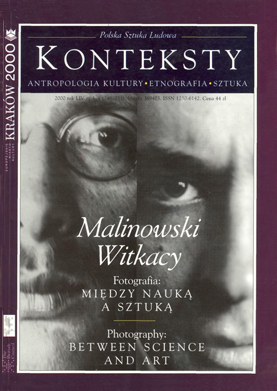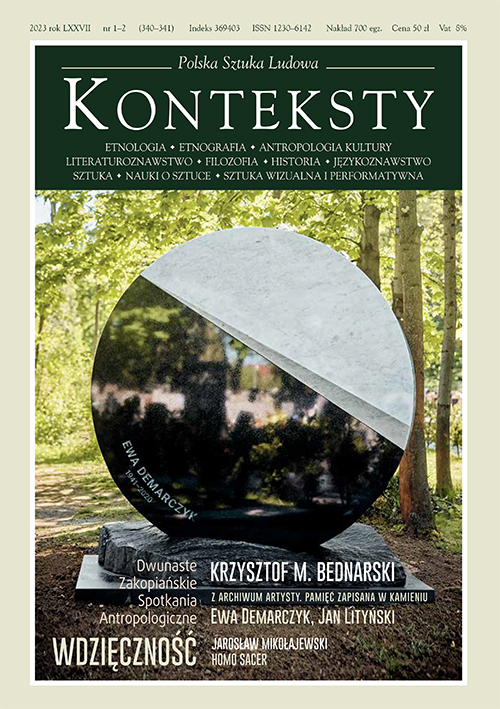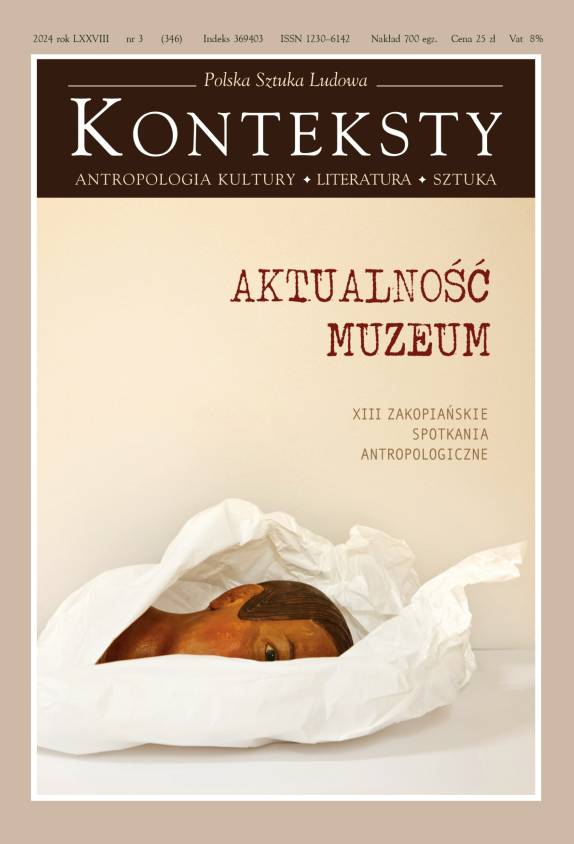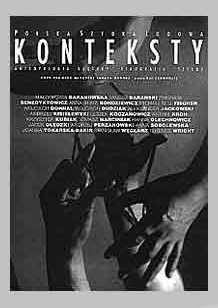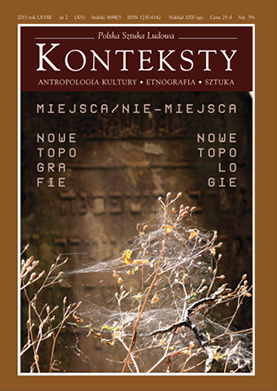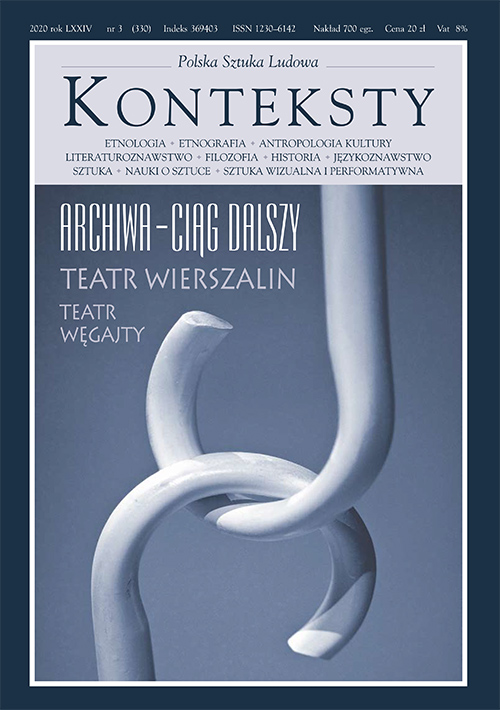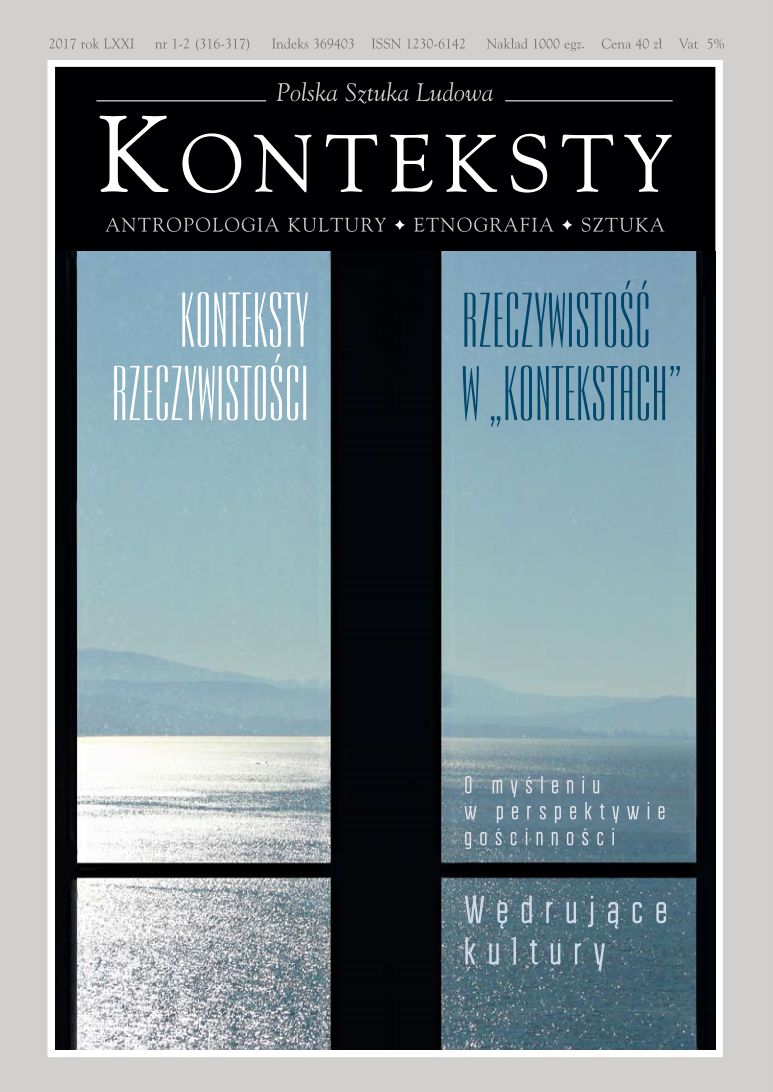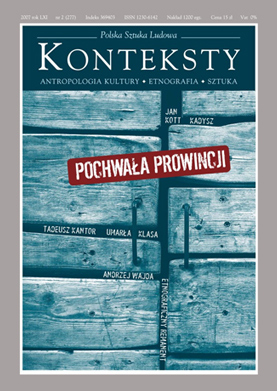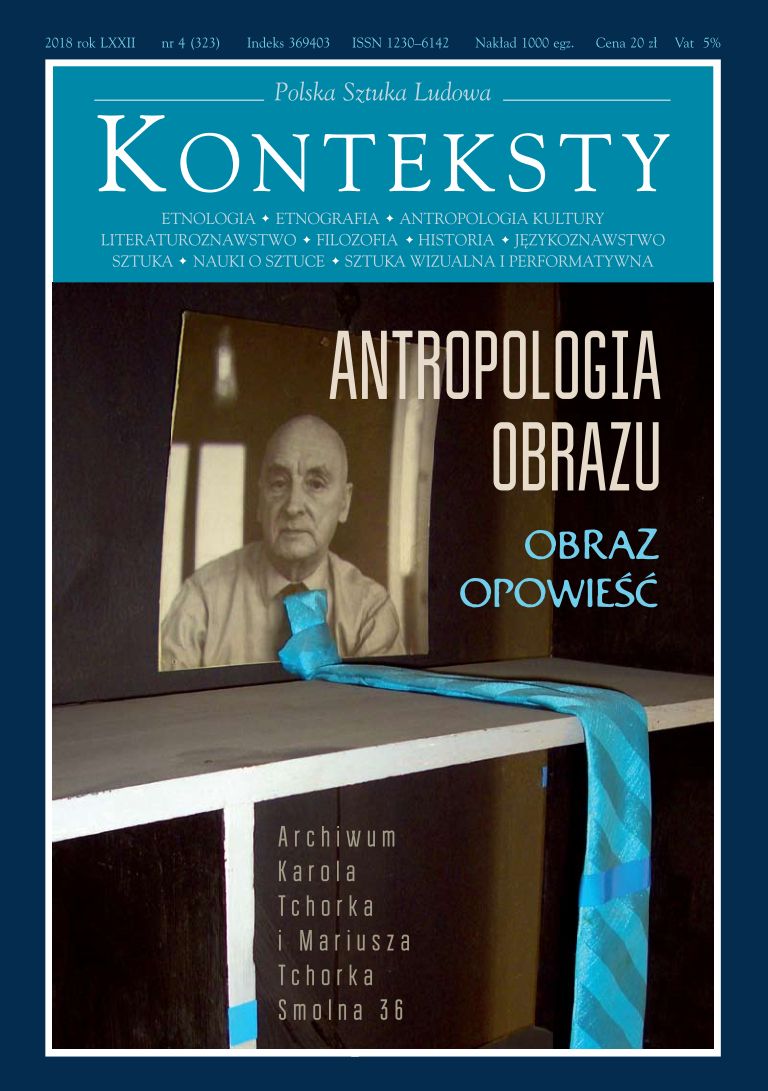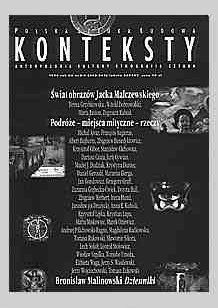Issue 1999/1-2 (244-245) - Konteksty

| Zbigniew Benedyktowicz | The Poor Itaka - Journeys, Mythical places, Things | |
| Objects in the Tadeusz Kantor Theatre | ||
| Małgorzata Dziewulska | The second life of Object  | |
Objects in the theatre of Tadeusz Kantor play a specific role. They cannot be treated as ordinary props, since they constitute rather antiprops. First and foremost, they include used second hand objects, discovered anew, sometimes extracted from daily life, frequently associated with the lives of the poor. Those "poor objects", suffused with emotion, can be abandoned, ignored, degraded, and possess special merits connected with memory (links with the deceased and childhood reminiscences). In the Kantor theatre such things perform an ennobled role; hence, the dramatis personae are often reduced to the status of mere things, and are empty, dead mannequins. Paradoxically, such "reduction" is tantamount to ennoblement. The object, matter comprises that which we encounter when we flee psychology. What is the nature of an object if it is better then the psyche? It simply must be spiritual, something concealed within matter, and superior to the latter. Through this material trait Kantor returned to the spiritual world, and in this specific manner he restored mythical qualities to cultural contents. The article by Małgorzata Dziewulska is supplemented by texts written by the students with whom she conducted courses (1996-1997). In the majority of cases, the objects were described solely upon the basis of a filmed version of two spectacles by T. Kantor: Niech sczezną artyści (May the Artists Perish) and Wielopole, Wielopole: E. Bielawska, The Camera - Machine Gun, T. Kalczyński, Doors, D.Novak, The Bed - Death Machine, A. Łoboda, The Tablecloth, D. Rembelska, Uncle Stasio-the Exile, K. Rekosz, The Handcar, M. K. Tylkowska, The Barrel-organ, and J. Kowalik, The Pool. | ||
| Edyta Bielawska | The Camera - Machine Gun | |
| Tomasz Kalczyński | Doors | |
| Dorota Nowak | The Bed - Death Machine | |
| Anna Łoboda | The Tablecloth | |
| Dominika Rembelska | Uncle Stasio - the Exile | |
| Krzysztof Rekosz | The Pillory | |
| Igor Gorzkowski | The Handcare | |
| Marta Krystyna Tylkowska | The Barrel-organ | |
| Joanna Kowalik | The Pool | |
| * | Music and Sound in the Spectacles of Kantor. Tomasz Dobrowolski, Małgorzata Dziewulska and Piotr Kłoczowski Talking | |
| Journeys, Mythical Places, Things | ||
| Jakub Szczuka | Per monstra ad sphaeram. Aby Warburg and His Library  | |
The library of Aby Warburg, an historian of art specialising in the Renaissance, is not a mere collection of books, but a museum of of the imagination and the collection of memories. Its purpose was to indicate the function of social memory, conceived as a force which renders possible the re-emergence of style, and a recognition of classical civilisations a permanent quality. Warburg maintained that the European civilisation is a process which constitutes the outcome of a collision of assorted tendencies. | ||
| Joanna Tokarska-Bakir | "The Blind librarian". On the Written Dimension of the Oral  | |
With a tangle of meanings, in which the written word and name appear in a religious-magic context, as the point of departure, the presented text demonstrates the possibility of comprehending writting as concealment (lethe in the Heideggerian sense of word), and as "rendering indelible by means of oblivion". Such an understanding of writting, characteristic for its sacral application, creates the specific style of culture, which could be described as "oral", in the meaning of term. | ||
| Piotr Szacki | The Unusual  | |
The unusual is a subjective and relative classification; in order that it may come into the being, it must be perceived and calls for a background: the context of ordinariness, contention and norm. It is sought-after feature, found almost everywhere (not only in the accomplishments of visual depictions), albeit with differentiated intensity, type and nature of effects, decisive for its presence: from natural phenomena to the formes of objects and scenarios of behaviour. From make-up to the oratorical manners, vocal and instrumental techniques. The presented text accompanied an exhibition featured under the same title in the State Ethnographic Museum in Warsaw (November 1998 - January 1999). The category of the unusual is not one of the categories frequently applied in museum pursuits. Hence, the exhibition can be treated as a search for a new sphere of meaning. | ||
| Stanislaw Łabiszewski | "Camera à la Minute",or a Tale by a "Five-Minute Photografer"  | |
Stanisław Łabiszewski (1916-1985) was a self-taught photographer. Fascinated by photography from his youth he did not devote himself to it until after his return from forced labour in Germany. Łabiszewski worked with a camera of his own construction, imitating so-called five-minute cameras (whose interiors contained an entire "chemical laboratory") - the client waited only five minutes for the ready picture.Łabiszewski, a resident of the Warsaw district of Praga, also painted the screens against whose background he took photographs in market squares and at church fairs all over Poland. The presented text is based on a vivid interview held by Piotr Szacki and Tomasz Potkański. The camera built by Stanisław Łabiszewski was purchased by the State Ethnographic Museum in Warsaw. | ||
| Jan Gondowicz | "A Naked Man on a Naked Earth"  | |
This reflection by a micro-essayist concerns things and their classification. An ambitious systematist would be compelled that things create around us a sphere without which it is impossible to exist without friction, as in the favorite example cited by physicists. To posses nothing is a sign of depersonalization, the loss of human condition, the antechamber of death. The contradiction of the naked man on a naked Earth is a person surrounded with all possible sorts of things, and situated on an Earth transformed totally into an entity of useful objects. The coming century will be encumbered with the task of describing this globe, whirling in the Universe and composed of chairs and holy pictures, oil refineries and plush teddy bears... | ||
| Agnieszka Tulik | The Travelling Barbarians  | |
The article presents the material aspects of journeys made by Franks and Longobards from the fifth century to the mid-seventh sentury. The author describes means of transport from the period and a brief history of particular inventions. She takes into considerations journeys made on foot, methods of crossing rivers (bridges, boats, fords, horseback, on shields), lodgings (and the hospitality of the hosts), meals during the journeys and items taken by the travellers. The sources material used as a base for the study include early medieval chronicles: Historia Francorum by Gregory of Tours, Historia Longobardorum by Pauls Diaconus and the fourth book of the Fredegar chronicle. | ||
| Krzysztof Cibor | A Non-existent Film, a Non-existent Town, a Non-existent Life. Propaedeutics of Wanderings beyond a Dictionary  | |
An attempted interpretation of a certain film about a journey to Venice. The fact that this film was never made does not stop the author from pursuing reflections about connections between the cinema, myth and life. Such deliberations posses the features of a journey during which we encounter, i. a. Thomas Mann, Witold Gombrowicz and Walter Benjamin, although to the end we are uncertain whether there exists any destination. The answer is: probably not. At the very last moment we become deported, sharing the lot of the heroes of the described film. That which cannot be reached comprises the concealed theme of the article. | ||
| Artur Setniewski | Dayroom, or about Two Kingdoms  | |
A description of travelling in a commuter train on the Warsaw-Pilawa line (about 60 kms.). The destination is both known and dangerous, and the journey itself is indispensable and run-of the-mill. The author delves predominantly into two kingdoms, mutually permitted and embroiled into a constant war. This battle is won by one side, but the other side must be the victor too. Freidrich Engels divided time and activities performed in it into the Kingdom of Necessity and the Kingdom of Liberty.The commuter train is a place in which the author and his fellow travellers spend time that belongs to the Kingdom of Necessity. The passengers are primarily peasants working in town and school children. Since it links two worlds: that of Mazovian village and the capital of the country, the train should be called rural. It was precisely the petty peasants from the suburban villages, travelling to their additional jobs in town, who performed a breakthrough in time and its activities by introducing a journey into the Kingdom of Freedom. For this purpose, they made use of a compartment which they named the Dayroom. | ||
| Maksymilian Rejmier | Holy Time and Holy Space  | |
The moment of crossing the French-British border is approaching. The magical dimension of activities encountered by every person passing through this frontier are decisive for its very nature. This is an excellent example of a place where we are dealing with contact between the sacrum and profanum. Crossing this border, the author felt that he had arrived from an indefinite space and was entering a territory of exceptional intense sacral qualities. | ||
| Wiesław Szpilka | Journey: The Sheltering Sky  | |
The author analyses vacation travels, universally present in contemporary culture. The scale and dimension of this phenomenon appear to testify that we are dealing with a particular type of cultural behavior which discloses the essential features of Western mentality. By means of comparison of holiday travels with the journey undertaken by the heroes of Bertolucci`s film The Sheltering Sky, the author accentuates a certain common feature: the periodical longing for freeing oneself from one`s world and structure of the rite of passage. | ||
| Marzena Gierga | Syracuse - The Town of Great Women Part II  | |
Syracuse is a town created by deities, saints, historians, trevellers, apologists, theologians, photographers, and, primarily, its own residents.It comprises a phenomenon located above a division into an urban and social subsystem, an area of eloquent meanings, a space for the realisation of concrete and specifical attitudes. The metaphorical, mystic-symbolic space of Syracuse is that of three women. This is the birthplace of Arthemis, the refuge and the site of the eternal rest of Arethusa, and the town of the birth, life and martyrdom of Lucia. By demonstrating of constant presence of the patron in the life of the city, which provokes assorted formes of group imagery, a process of rendering space mythical, and a creation of a world of values shared by its residents, Syracuse gains new meaning. It appears as a town of light. a land of purity, saintliness and glory, a city of luminescence and joy. Its topography is superimposed upon that of its inhabitants, and vice versa, while observed behaviour is granted a double meaning, and comprises an example of the observation of a distinguished place, but also of a transformation of a myth into a ritual, frequently without social awareness. Its outcome assumes the form of the specific dramaturgy of the everyday life of the population of Syracuse, whose sense of existence is restricted to an encounter with the three patrons, advocates,guides and friends, a fact which entitled the author to describe it as "the town of great women". The presented cult of St. Lucia is more of a cult of her image than the worship of saint,while a version of the hagiographic legend becomes a reference to a myth. That what, at first glance, appears to be contradictory, is encountered on the ethical level of a symbolic structure. By the refering to an analysis of the fundamental structure of those transmissions, with different contents but similar form and meaning, the author demonstrates the symbolic continuum of elements characterising Syracuse across the ages. The point of departure for such journeys was the ascertainment of the "strangeness" of this place, disclosed by the omnipresent cult of St. Lucia and her pagan companions in assorted aspects of culture. Their outcome assumed the form of co-existence of the literary-metaphorical topos of Syracuse and its real, magical-ritual counterpart. | ||
| Marek Oziewicz | What`s to be Found in Wardrobe? Parallel Worlds ofC. S. Lewis`s Chronicles of Narnia Part II  | |
The author attempts to analyze parallel worlds described by Lewis in his Chronicles of Narnia and focuses particularly on the issue of passage from one world to another. Having initially classified "other realities" of the Chronicles into secondary and parallel worlds, the author concentrates on their status and characteristic features of their spatiotemporality. Attention is then drown to magic places in which parallel realities overlap or cohere which broad background allows to examine the mechanics of the characters` passages from one world to another. This done in the light of the Eastern (and partly medieval) theory of the elements: space, air, fire, water and earth. In the main part of his work, the author proposes a classification of all instances of passage between different worlds present in the Chrolicles into four categories: direct volitional, indirect volitional, direct nonvolitional and indirect nonvolitional. The division between volitional and nonvolitional passages is constructed upon the feelings which present themselves to the characters during the procedure of passage, whereas the division between direct and indirect ones - upon mutual relationship of the worlds between which the passage takes place. Drawing on examples from the Chronicles, the author endeavours to substantiate his thesis applying in his analyses the technique of gradation of sensory impressions. | ||
| Dariusz Czaja | Chair. A Sketch to a Portrait  | |
The author proposes a new and fresh look at this very ordinary, familiar and tame object in our day life. A reference to poetry (Herbert, Białoszewski, Rymkiewicz and Brodski) and to the examples from the fine arts (Bendnarski, Mickiewicz, Pągowska, Kantor) shows that underneath the shell of ordinariness, automatic associations and modes of thinking about a chair, there remains embedded an unrecognised, strange and mysterious reality. | ||
| Agnieszka Makarewicz | The Ball  | |
What is a ball? The author tries to answer a question concerning the nature of this question by reffering to the Ball, a poem by Rilke and to three short films by Zbigniev Rybczyński: Tango, New Book and The Duel. She brings forth and comments on motifs associated with the ball, from obvious ones such as sport and entertainment, to metaphorical and symbolic ones: game, Life, motion and sacrum. | ||
| Danuta Bolikowska | Smoke  | |
This impression was inspired by Smoke, the by Wayne Wang, and ideas contained in, i.a. studies by M. Eliade, R. Barthes and B. Bettelheim. The resultant long poem considers meetings of people bending over an album containing photographs of their small homeland or last love, and bonded by cigarette smoke. The author follows the fate of the heroes of Smoke by employing Freudian psychoanalysis and the outcome of research by the American psychiatrist Rollo May. Resorting to tales and myths, she identifies conscious and subconscious longings, wishes and strivings, which prove to be contemporary America`s "plead for a myth". | ||
| Katarzyna Kuszyńska | Cigarette and Ashtray  | |
Cigarette advertisements suggest that we should choose between smoking and health. With the text of a ministerial warning that accompanies advertisements as her point of departure, the author recalls the historical origin of the appearance of this stimulant in Europe and ensuing problems. In a further part of her study, which refers to literary texts (Sosnowski, Stasiuk, Baran, Swietlicki) and films (Smoke, Brooklin Boogie, Coffee and Cigarettes), she discloses the metaphorical meaning connected with the cigarette.Emphasis is placed on its ontology (permanence and illusiveness) and, chiefly, its paradoxical symbolic, which combines the essence of vitality and reflection on death. | ||
| Marceli Zygała | Fumare humanum est. A Brief Lexicon of the Tobacco Stimulants Around Us  | |
Tobacco is omnipresent. It succumbs to culture as well as creating it. Propagated or persecuted, it continues to exist, leaving no one indifferent. By citing several ways of using tobacco (smoking, snuff, chewing) and intentionally exaggerated examples, the author tries to draw attention to the whole gamut of "tobacco" behavior, full of delicate hues and located between the two extremities. The article is a sample of an M.A. dissertation written in the Chair of Ethnography and Cultural Anthropology at Warsaw University. | ||
| Krystyna Gieryszewska, Marcin Szporko | Gren Leaves in the Streets of Berlin  | |
The text is the outcome of research conducted by a Summer School in the Chair of European Ethnology at Humboldt University in Berlin. Already superficial studies on the consumption of hemp products discovered a multi-aspect application. The stimulants obtained from hemp (hashish and marijuana) are only a fragment of the extensive usage of hemp in Berlin. Hemp is consumed in Berlin directly - as a stimulant, fabric and clothes, and a component of paper, beverages, cosmetics, etc.,as well as in a symbolic dimension. The symbol of the hemp leaf became, to a certain degree, a designate of a pro-ecological lifestyle which, according to proposed self-definition, remains alternative vis a vis technical civilisation. Adherents of an all-sided consumption of hemp argue that as a crop, hemp is "environment friendly", and as raw material it has multiple (50 000) uses. The residents of Berlin are supplied with hemp products (with the exception of stimulants) by rather numerous specialized shops (Hanf Hauses). The Berlin Hemp Museum, opened in 1994, and a special unit of Green Party, which supports the legislation of hemp as a stimulant, are examples of institutionalised interest in the positive aspects of the consumption of this plant. | ||
| Ireneusz Kamiński | Bus  | |
According to Red Vonnegut a bus is a box for carring people from one place to another. Applying such "objectivised" images of the bus present in art (i. a. Nowa książka /New Book/- a film by Zbigniew Rybczyński, the paintings by Bronisław W. Linke and the book by Red Vonnegut Na klęczkach /Kneeling/) as well as his own observation the author proposes a cultural-sociological study of the phenomenon of the bus, and the behaviour and customs associated with bus rides. | ||
| Jarosław Jot-Drużycki | "Vlepka", or the Interpretation of a Bus  | |
"All faces on a bus look the same", claims a vlepka. A "vlepka" is a sticker, with a short text, poem slogan or drawing, placed in the back of Warsaw buses. The author describes this new phenomenon (1996-1998) of the local subcultures, drawing attention to the places in which the vlepka appears (the back of the bus - the appraisal of the rear...), the need for a community, which signifies also a common enemy (the "battle" waged by the person placing the stickers and those tearing them off, reflected in the texts of particular vlepkas) as well as unitentional reference to futuristic traditions. | ||
| Jacek Olędzki | The Fleeing Art of Innocence  | |
The author draws attention to vlepki, stickers bearing small pictures and inscription, and placed in buses. Thanks to the activity of young creators, municipal transport turns into a scene witnessing an exchange of thought. Olędzki examines the undertaking of one of those groups,which is by no means restricted exclusively to buses and appears in the streets. | ||
| Chana Pollack | To and from Ostrowiec via Bus  | |
The leitmotif of the text are journeys by bus (the titular PKS) between Warsaw and Ostrowiec Swiętokrzyski, made by the author (a Fulbtright Research Scholar) for the purpose of gathering data for a film about her grandmother, a resident of Ostrowiec up to emigration in 1923. Letters written in 1920-1923 to a husband seeking employment and a new home in the U. S. A. and Canada constitute a source of inspiration for the film and important material utilised therein. The presented text combines experience from those travels with more general reflections about the fate of the Polish Jews and the traces, frequently enigmatic, of the once thriving Jewish culture in Poland. | ||
| Sylwia Trzaska | John Maizels, Raw Creation. Outsider Art and Beyond | |
| Janusz Barański | Pluralis non maiestaticus, or People as Things  | |
At least from the time of Sapir and Whorf it is known that language is a medium which acts as an intermediary of the relation between our consciousness and all that which remains beyond it. This feature is particulary vivid in the case of assorted formes of the emotive use of language, including its application in a magical or rhetorical function. The author interprets a device known to scholars dealing with rhetorics, namely the so-called pluralis,envisaged as an expression of a magical world outlook that is by no means a domain exclusively of so-called traditional societies, but it present equally forcefully in modern and postmodern culture, especially in the realm of politics. Pluralis appears as a rhetorical costume for draping political clans in axiologically valorised meanings. On the one hand, manipulation with the names of political opponents exhausts the symptoms of magical operations and, on the other hand, comprises part of a larger whole, i. e. the political game, a contemporary ritual of sorts. | ||
| Dorota Hall | Escape into the Screen  | |
This brief essay comments on the view expressed by Leszek Kołakowski: "Who needs seventy television channels? Everyone, since it is manner way of fleeing from absurdity into absurdity". The author considers where (and how)is it possible to seek refuge in an era of omnipresent simulation and a postmodern world devoid of a cantre, and discusses the nature of the absurdity which is the destination of the escape. | ||
| Marcin Kafar | Live in the Rythm of 230 Bits/Minute | |
| Dorota Gut | On the Other Side of the Screen  | |
The present texts deal with the Internet, virtual reality and other phenomena associated with computer technology, showing that behind the computer screen there starts a world which introduces its own spatial divisions and establishes its own laws. The author describes the topography of this world and the ways of travelling across it. | ||
| Dorota Gut | Scribo ergo sum. On the Internet Language | |
| Magdalena Radkowska | The Hyper-reality of Lara. The Lara of Hyper-reality  | |
The author discusses Lara Croft, heroine of one of the most popular computer games (Tomb Raider). This super agent, endowed with the extraordinary physical prowess, is capable of taking all conditions and every enemy. Her admirers accentuate her uncommon beauty - voluptuousness, a long braid, perfect make-up and fashion style: a silicone blouse, shorts combat boots and a belt with an attached gun, with which she never parts. The author considers the popularity of Lara, who appears on numerous Internet pages, in comic books, a video clip and, in the near future, will star a film. In real life, she is enacted by an English actress. Many girls pretend to the role of the earthy representative of Lara, and dream about becoming her embodiment. The story about virtual heroine is also a pretext for reflection on the phenomenon of hyper-reality (Baudrillard) and the relation between the text (in the wide meaning of word) on the computer screen and the traditional text from the age of Gutenberg galaxy. | ||
| Dorota Kołakowska | The Planet Diana - an Attempted Analysis of Reactionto the Death of the Princess of Wales  | |
An analysis dealing with the extraordinary phenomenon of worldwide reactions to the death of Diana Spencer, Princess of Wales. The text is based on press reports from the period immediately after the death of the Princess (31 August - 6 September 1997). The author concentrates attention predominantly on individual reactions registered by reporters - the object of the analysis are, therefore, quotations from official statements (speeches, condolence letters) and the private comments and opinions, gathered from people in the street. Such material produces an image of the Princess as a sui generis consumer commodity, a specific virtual creation of the media. The attitudes accompaning her death (pseudo-religious adoration, the need to confirm one`s own existence and a desperate search for community bonds) appear to be an attempt at deceiving the emptiness generated by a confrontation of this "safe" creation with reality, the concrete and irreversible fact of individual death. | ||
| Tomoho Umeda | Audiophilia  | |
In the article Audiophilia the author analyses the concept of hyper-reality upon the example of the titular phenomenon. His reflections concern the perception of hyper-reality owing to assorted reference systemes, i. a. semiological and hermeneutic. | ||
| James Clifford | Tell me about you Trip: Michel Leiris | |
| Olga Łobaczewska | The Visit in the Kingdom of Lilia I  | |
This realm is situated in a humble village cottage in the Belorussian region of Polesie. Its queen is the native painter Lilia Szpakowska (Shpakovskaya), who lives in an imaginary, fairy-tale world of her imagination. | ||
| Bronisław Malinowski | ||
| Bronisław Malinowski | Diary 1914-1918. | |












